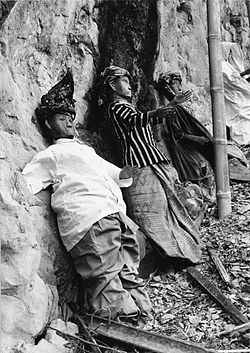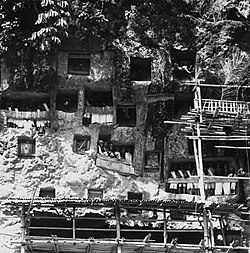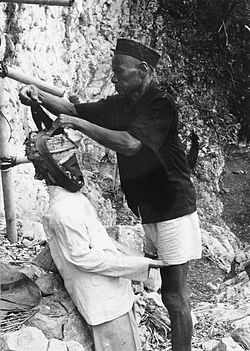
Several tau tau of Torajan noblemen, 1972

Tombs carved into the rock face near the village of Lemo. Several tau tau guarding at tomb entrance, 1971

Tau tau of a Sangalla nobleman being dressed, 1972
Tau tau are a type of effigy made of wood or bamboo. They are particular to the Toraja ethnic group in South Sulawesi, Indonesia. The word "tau" is a Torajan word meaning "man", and "tau tau" meaning "men" or "statue".[1]
Tau tau are believed to have originated in the 19th century. They were once produced only for the wealthy, to reflect the status and wealth of the deceased.[2] The tau tau are representatives of the deceased, ever-guarding the tombs and ever-protecting the living. In the early 1900s, with the arrival of the Dutch Christian missionaries in Toraja, the production of tau tau was somewhat dampened. In 1972, at least 400 visitors attended the funeral ritual of Puang of Sangalla, the highest-ranking nobleman in Tana Toraja and the last pure-blooded Toraja noble. The event was documented by National Geographic and was broadcast in several European countries.[3]
In 1980s, the wooden effigies became a target for grave robbers, sold to museums. As the Torajans believe that the dead can take their possessions with them to the after life, the effigies are usually equipped with all sorts of possessions. They were plundered along with the effigies. They were soon to be found in Jakarta, Europe and America,[3] they were once even on display at the Smithsonian Institution in 1991. In response, the Torajans hid their tau tau in undisclosed location. They installed metal fences surrounding their house to protect the tau tau outside their house. It is somewhat ironic that the tau tau is meant to represent the deceased protecting the living, but they now have to be protected against the living.[4]
Traditionally, the effigies were simply carved, only to show the gender of the deceased. However, they have become more and more elaborate, actually attempting to imitate the likeness of the deceased. The types of wood used for the effigies and what they are clothed in also reflect the status and wealth of the deceased. Tau tau of the wealthy would generally be made of wood from the jackfruit tree. They are usually permanent statues that can be found standing at the entrance of tombs, which are carved out of rock faces of Toraja. Their position, in reference to the other tau tau, in the rock face would indicate the status of the deceased. Only the rich can afford the permanent tau tau as they require specialist stonemasons or cave builders who are able to hollow out the cave out of the rock formation. The cave builders usually require payment of several buffalos that only the sufficiently wealthy can afford.[1] The less wealthy generally have their tau tau made from bamboo, which will be undressed at the end of the funeral, leaving only the bamboo on the ritual field.[4] Tau tau representing deceased infants are placed inside a hollowed-out section of a living tree.[1]